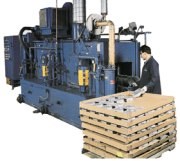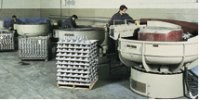Finishing for the Metalworking Masses
Concentric Reliable Works started its mass-finishing business with a homemade machine...
Just about every part that is machined, stamped, cast, forged, heat treated or fabricated must be subsequently cleaned and/or deburred. That is where CRW Corporation, Addison, Illinois, enters the manufacturing process.
"We run the last operations the machine shop thinks about, although what we do is just as important as actually making the part. You cannot do anything with the part until we are finished with it," stated Steve Kendrick of CRW (Concentric Reliable Works). The company has been providing mass-finishing products and services to the metal working industry since 1977, when Charles Calbeck built a deburring machine and opened his doors to the Chicago market.
CRW's primary business is vibratory finishing, shot blasting, aqueous spray washing, deburring, burnishing and belt blasting of steel, aluminum and die cast parts. The company has 290 cu ft of deburring equipment, two shot blasters and a continuous belt blaster.
Mass-finishing processes, such as those employed at CRW, are used for deburring, deflashing, edge and corner radiusing, improving surface finishes and cleaning, which involves removing rust, scale and other surface contaminants. Mass finishing can also be used to change surface profiles, generate surface textures for coating or painting, modify surface stresses, inhibit corrosion, dry parts and apply coatings such as lubricants and waxes.
For each job, CRW matches the best mass-finishing method to the part and the customer's desired end finish.
Vibratory Finishing. CRW uses Roto-Finish round-bowl-type vibratory finishers and chemicals to do much of the work. These systems have an eccentric weight mounted vertically inside the center section of the doughnut-shaped bowl. The weight provides the vibration needed to deburr, clean and/or finish the parts. The vibratory action can be adjusted for metal removal rate and feed rate for separation.
The media-parts mass moves around the chamber in a circular motion. Generally, the mass has a ratio of three parts of media to one part work by volume. This ratio is dictated by the size and geometry of the part and the quality of the surface finish needed.
"For example," noted Mr. Kendrick, "general deburring may be at a three to one ratio while preplate finishing may be at a six to one ratio." The media mass moves in a gently controlled spiral action around the chamber.
Media choices include ceramic, plastic, random-shaped aluminum oxide and case-hardened steel media.
Ceramic media is the most widely used for heavy and light deburring. It is capable of generating surface paint adhesion when used with the correct chemicals.
Plastic media is used for medium to light deburring and generating surfaces suitable for subsequent paint application. It is also used for preplate preparation. Both ceramic and plastic media create drainage problems as they get smaller (less than 1/8 inch). The pieces can clog the drain.
Case-hardened steel media comes in various shapes and sizes. It usually runs about 300 lbs/cu ft. It is used for minor edgebreak, cleaning and burnishing. Because it is long wearing and has a precise size, it can eliminate lodging, and hence drain problems.
Some mechanical finishing is done without chemicals or water. The dry method is used when the parts are flat and moisture would cause "nesting" or sticking of the parts. This is a slow process, but sometimes necessary.
Most often a chemical compound is dispensed by a precision compound pump and flow-rate-control meter. The chemical used depends on the parts. "A typical setup," explained Mr. Kendrick, "would be at a rate of two gallons of flow per cubic foot of capacity of the machine with one ounce of chemical per gallon of flow rate."
The systems can have simple or complex control panels. Three variables must be controlled. Most vibrators run at a fixed rpm, with variable amplitude adjustments. Others operate with a variable-speed drive and some have a fixed-speed drive. Another variable is media attrition. Abrasive media wears and diminishes in size and volume. There is an attrition rate of x lbs/hr of running time. To control the process, Mr. Kendrick recommends that you not allow the volume of media in the machine to vary more than one cubic foot. The third variable is media classification. Media shape and size are chosen to prevent lodging in holes, crevices and the like. Media need never leave the vibratory finisher if a media separation device is used.
Processing times range from 20 minutes to several hours; however, most applications are complete in three to 20 min of continuous processing.
Shot Blasting. CRW also offers its customers shot blasting. It has a Goff shot blaster, Bronco blaster and a new BCP belt blaster, which provides continuous operation. "The belt blaster will separate us from our competition," Mr. Kendrick stated. "No one else has one."
The belt blaster provides for through-feed operation rather than batch runs. The part opening is 12-inches high. The belt width is 28 inches. Part size will run nine inches by 24 inches and smaller. Because the new belt blaster is bringing more work, CRW purchased an additional truck and driver to pick up and deliver parts. "When I started, turnaround was a week. Then it went to three days. Now it is 24 hrs or less," Mr. Kendrick noted. The company has always had enough equipment capacity to get the job done.
CRW also has Blast-It-All and Econoline sandblasters. The two main methods of blast finishing are dry and wet. Dry blasting uses pressurized air or airless processes. In airless or mechanical blasting, media are thrown against the work surface using centrifugal force. Airless blasting is used most commonly in batch and continuous equipment, especially when a large media volume is needed on a large work area.
In wet blasting, the media are suspended in water that is forced by compressed air through nozzles to clean or finish the parts.
Blasting can be used to roughen a part surface prior to coating. The process can also be used to smooth a part. This includes removing burrs, flash, grinding lines and other surface imperfections.
Aqueous Spray Washing. CRW also offers spray washing in a three-stage system. It features an alkaline clean, rinse and dry. The closed loop system removes mill oils, lubricating oils and rust. Often parts that will be shot blasted are first cleaned in the aqueous washer because the blasters cannot handle too much contamination.
Waste Treatment. Most operations use ceramic media, although plastic and steel are also used. Corncob is also mixed in on occasion for drying parts. Corncob is a good oil absorbent. Spent corncob is simply crushed and hauled away as a dry waste.
A new system was recently installed to handle the wastewater from the mass-finishing processes and cleaning line. The wastewater generated at CRW contains just about any and all ferrous and non-ferrous metals.
CRW. The company not only provides finishing services, but supplies equipment and systems. It also tries to help others understand mass finishing. CRW hosts seminars on vibratory finishing and will soon host one on wastewater treatment for the mass-finishing industry.
CRW is also pursuing ISO 9000 certification. "We have found a growing need for us to be certified; for our customers' benefit," noted Mr. Kendrick. The company has grown since its inception. In 1994 it processed 66,203,960 pieces. In 1996 that number rose to 1,098,225,990.
"We are proud of what we do and what we have accomplished. In today's competitive market it is not enough to provide good quality, we must provide better quality," stated Chuck Calbert, founder and president.
| TABLE I—Media Selection Guide | ||
| Effect Desired | Degree of Effect | Media Recommended |
| Deburring | Light Medium to Heavy |
Steel or Ceramic Ceramic or Plastic |
| Radiussing | Light to Heavy | Ceramic or Plastic |
| Surface Roughness | Reduce to Lower Values Preplate Quality on Softer Alloys |
Plastic or Ceramic Plastic, Ceramic Plastic —> Plastic, Plastic —> Steel, Ceramic —> Steel, Steel or Hardwood |
| Surface Reflectivity | Brighten or Highlight Best Quality, Hard Alloys Best Quality, Soft Alloys Best Quality. Plastics |
Steel or Ceramic Ceramic or Ceramic —> Steel Plastic —> Steel Hardwood |
| Clean Surfaces | All Metals Irregular Surfaces |
Steel, Ceramic Random-Shaped Media |
| Least Operating Cost | (varies greatly with the grade involved) | Steel, Ceramic Plastic, Hardwood |
| Fastest Speed of Processing | (be sure to understand overall media capabilities here) | Steel, Ceramic Plastic, Hardwood |
| Notes: Evaluate all pertinent factors before making a selection. Preferred media is listed first. (It may be very inappropriate for the overall requirements of the part.) Two-step processes are denoted by the "—>" between media steps. Media not listed does not infer unsuitability. | ||
Read Next
Delivering Increased Benefits to Greenhouse Films
Baystar's Borstar technology is helping customers deliver better, more reliable production methods to greenhouse agriculture.
Read MoreA ‘Clean’ Agenda Offers Unique Presentations in Chicago
The 2024 Parts Cleaning Conference, co-located with the International Manufacturing Technology Show, includes presentations by several speakers who are new to the conference and topics that have not been covered in past editions of this event.
Read MoreEpisode 45: An Interview with Chandler Mancuso, MacDermid Envio Solutions
Chandler Mancuso, technical director with MacDermid Envio discusses updating your wastewater treatment system and implementing materials recycling solutions to increase efficiencies, control costs and reduce environmental impact.
Read More













.jpg;maxWidth=300;quality=90)







